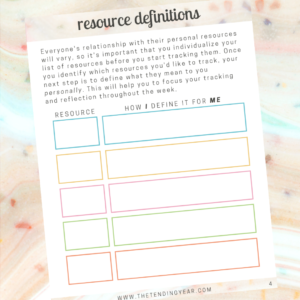We rely on our resources to accomplish our goals.
In order to learn how to better manage my personal resources, I spent a whole week documenting and analyzing my experience with specific resources (money, time, energy, focus, willpower, presence, and connection, to be exact) and then used my reflections to shift my actions with more intention and awareness.
I formatted my process of note taking, reflecting, analyzing, and determining action steps into a FREE COMPANION WORKBOOK that you can download, print, and use for your own personal resource management. Read through the four steps for the practice below to learn how to define, track, evaluate, and manage your personal resources with more attention and awareness. And then download the workbook at the end of the post. If you want to explore more exercises check out my book Tend to It: A Holistic Guide to Intentional Productivity.
Step 1: Identify and Define Your Resources
Everyone’s relationship with their personal resources will vary, so it’s important that you individualize your list of resources before you start tracking them. Examples of personal resources might include (but are certainly not limited to): time, energy, focus, willpower, money, mood, presence, connection, support, spoons, and more.
Once you identify which resources you’d like to track, your next step is to define what they mean to you personally. This will help you to focus your tracking and reflection throughout the week. Remember, your definition does not have to look the same as someone else’s!
Here’s some examples from my own answers to the workbook’s “Resource Definitions” page:
Focus: my ability to work on task/s for predetermined amounts of time without getting distracted or losing interest.
Spoons: my level of spoons is directly related to the combination of my level of chronic pain, my attitude towards my current situation, and the amount of physical energy I feel like I can expend and still feel present and functional.
Step 2: Track Your Resources Daily
At least once a day, jot down some notes on how you’re feeling about each individual resource. You can choose when works best for you to record your notes, but I suggest later in the day so you have more to report on (I wrote my notes while I ate dinner).
It’s also up to you how many days you’d like to track your resources, but I found that a span of 5-7 days was ideal for me because as the days passed I found myself approaching my daily personal resource expenditures with more awareness. There’s a “Daily Resource Tracker” page in the workbook that you can print and fill in for each day.
Here’s a couple examples of things I recorded in my “money” section of that page:
4/30/19: I realize I am pulling from my savings more than I would like to be and then refillling the savings at the end of the month. I need to reflect on why I am doing this and how I can shift out of the practice.
5/1/19: I feel more calm and confident when I approach things with an abundance vs. a scarcity mindset.
Step 3: End of Week Reflection
General Reflection
Once you’ve made it through a number of days, look back through your daily notes and identify any interesting themes, patterns, or questions that come up for you. Record your general reflections for each individual resource in the “End of Week Reflection” page.
Here’s an example of one of my End of Week Reflections:
Presence: having a massage in the evening felt like a bridge from work to relaxing; I like choosing to take breaks from podcasts/audiobooks and either listen to nothing (i.e., while grocery shopping) or to jazz (i.e., while driving home from reiki); when I felt low energy and bummed out, I wanted to check out with entertainment (TV, Instagram, Pinterest) instead of feeling present.
Highs and Lows
After you’ve reviewed your daily resource notes, identify key highs and lows you experienced with each resource throughout the week. You can interpret high and low in any way you like (I interpreted high as success/joy/comfort and low as stress/difficulty/disappointment). There’s a page in the workbook dedicated to specifically to this, aptly called “Highs and Lows.”
Here’s some examples of highs from my week:
Mood: I feel such a mood boost of calmness/presence/connection after I see my healers; I feel genuinely excited about my research when I don’t put pressure on myself to “produce” and when I shift my perspective on what good researching can look like.
Here’s some examples of lows from my week:
Willpower: I struggled to do my stretches when I was experiencing low energy due to PMS; I didn’t want to do research when I was upset because I felt that I wasn’t making any progress.
More and Less
Now that you have awareness of what worked well or not so well in your week, identify what you would like more and less of for each resource moving forward and record it in the “More and Less” page of the workbook.
Here’s some examples of what I wanted more and less of after my end of week reflection:
More: eating consistent snacks (especially before physical energy expenditure) makes me feel better; I want to work on accepting that when I’m in the week before my period that I will not have as many personal resources to dedicate to things as usual.
Less: it’s okay to say no to social obligations if I am tired and low on spoons; if I am ahead in my work for my dissertation and the blog, it’s okay to take time off of research to focus on errands or really just relaxing; beware of sneaky work that doesn’t feel like work.
Step 4: Looking Forward
Ideal and Not Ideal Experiences
I love thinking through systems and layering ideas on other ideas to see what new things I can discover, so this one was super fun for me! To do this step, you need to consider what you feel like when you experience two separate resource expenditures at once.
Here’s how I approached filling out the “Ideal Resource Experiences” page of the workbook:
Time + Spoons: definitely the morning. When I wake up I usually have the highest energy, lowest physical pain, and highest focus of the whole day.
Money + Mood: having a budget and plan for how I can pay my bills and have money left over to both contribute to my savings accounts and to buy myself a little treat.
This venn diagram style of thinking also works for the least ideal combinations. Here’s an example I wrote on the “Least Ideal Resource Experiences” page:
Energy + Focus: I know that I really struggle to focus on critical thinking tasks when I am tired at the end of the day.
Action Steps
Now that you have done such a deep level of data collection and analysis, you should have a good grasp on how you would like to build up or expend your personal resources moving forward. Look back over all of your answers and identify one explicit action step for each resource and then start making positive changes with awareness and intention!

This week’s takeaway is the aforementioned FREE companion workbook for managing your personal resources. Click the purple button below to access your own copy!
Here’s a sneak peak of one of the workbook pages:

Newsletter
Sign up below to access my free newsletter, Tending with Dr. Kate Henry.

